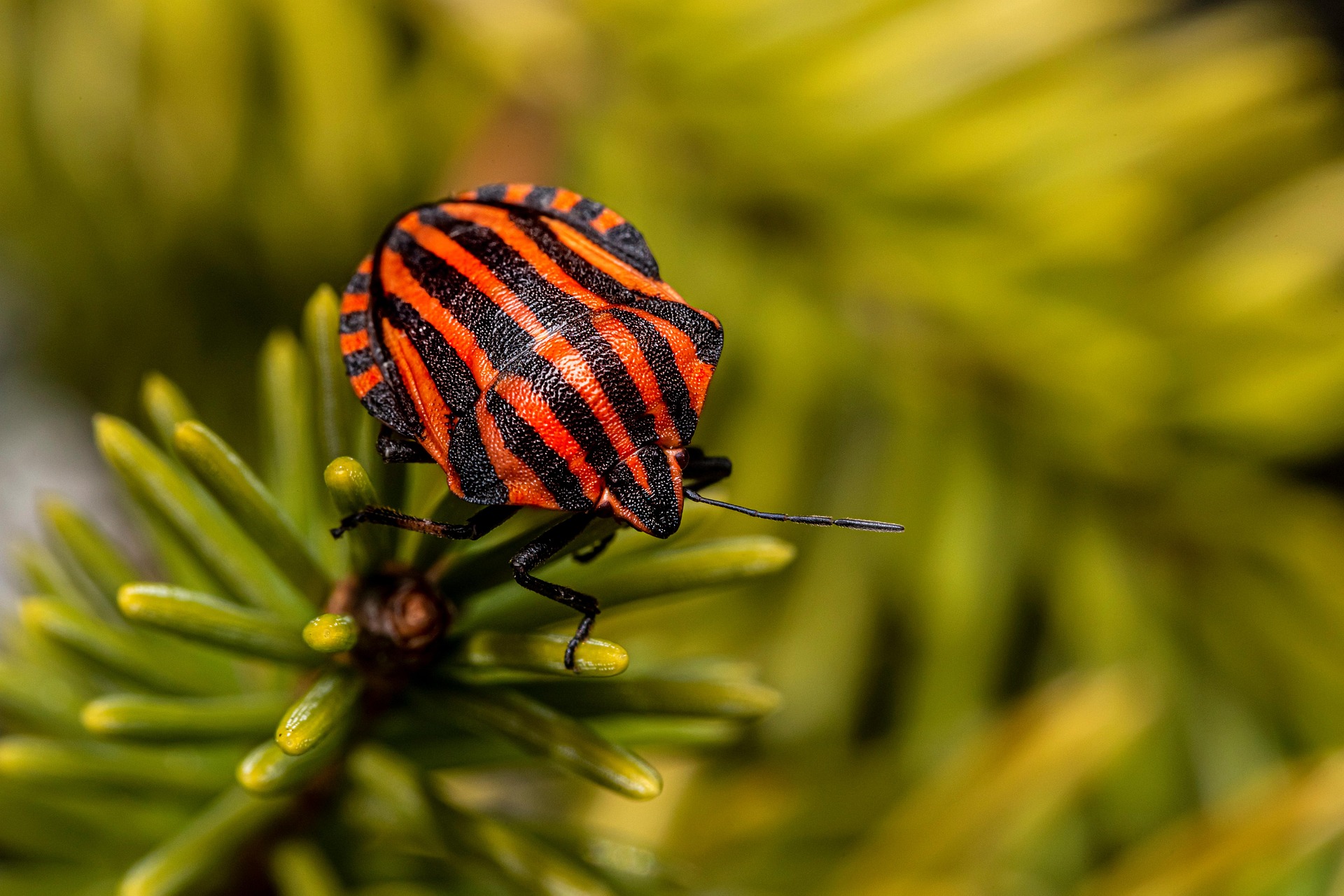Here’s a complete overview and description of the striking Italian Striped-bug (Graphosoma lineatum), one of Europe’s most recognizable true bugs thanks to its bold red-and-black stripes.
🐞 Italian Striped-bug (Graphosoma lineatum)
Taxonomy
- Kingdom: Animalia
- Phylum: Arthropoda
- Class: Insecta
- Order: Hemiptera
- Family: Pentatomidae (Shieldbugs)
- Genus: Graphosoma
- Species: G. lineatum
Scientific name: Graphosoma lineatum (Linnaeus, 1758)
Common names: Italian Striped-bug, Minstrel Bug, Striped Shieldbug
Identification
The Italian Striped-bug is a medium-sized shieldbug easily recognized by its striking red or orange body with black longitudinal stripes. It is one of the most colorful true bugs found in Europe.
- Size: 8–12 mm in length
- Coloration:
- Bright red or orange background with six black stripes running lengthwise on the upper body (including the pronotum and scutellum).
- The underside is mostly black with small red or orange spots.
- Shape:
- Typical shield-shaped body, rounded and slightly convex.
- Antennae black, with five segments.
The coloration serves as aposematic warning — signaling that the insect may taste unpleasant to predators.
Distribution and Range
Graphosoma lineatum is widely distributed across the Palearctic region, especially in southern and central Europe.
Found in:
- Southern and central Europe (especially around the Mediterranean)
- North Africa
- Middle East
- Western Asia
In recent decades, its range has expanded northwards due to warmer climates.
Habitat
Prefers sunny, dry, and warm habitats such as:
- Meadows and grasslands
- Roadsides and field margins
- Hillsides and scrublands
- Open woodland edges
It is often seen on umbelliferous plants (Apiaceae) such as wild carrot, fennel, or hogweed, where it feeds and mates.
Behavior
- Diurnal and slow-moving: Often seen basking in sunlight on flowers.
- Social tendency: Frequently found in groups, especially during mating or feeding.
- Flight: Can fly, but generally moves slowly and relies on its coloration for defense.
- Defense: Emits a strong-smelling secretion from thoracic glands when disturbed, deterring predators.
Diet
A sap-feeding herbivore, the Italian Striped-bug uses its piercing-sucking mouthparts to feed on:
- Stems, seeds, and fruits of Apiaceae plants (carrot family)
- Occasionally other meadow plants
Common host plants include:
- Daucus carota (Wild carrot)
- Foeniculum vulgare (Fennel)
- Pastinaca sativa (Wild parsnip)
- Heracleum sphondylium (Hogweed)
Life Cycle
1. Mating:
Occurs during spring and summer; pairs can often be seen connected tail-to-tail for extended periods.
2. Eggs:
Females lay clusters of barrel-shaped eggs on host plants.
3. Nymphs:
- Wingless and more rounded than adults.
- Initially orange-brown with dark markings.
- Go through five instar stages, gradually developing adult colors and wings.
4. Adults:
Emerge in summer, overwinter in leaf litter, and reappear the following spring.
Generations: Usually one per year in cooler regions, two in warmer Mediterranean climates.
Similar Species
| Species | Key Difference |
|---|---|
| Graphosoma italicum | Some taxonomists now consider G. italicum the Mediterranean subspecies of G. lineatum. |
| Graphosoma semipunctatum | Has black dots instead of stripes on the pronotum. |
| Graphosoma rubrolineatum | Paler red coloration, smaller range in Asia. |
Note: Many sources now treat Graphosoma lineatum italicum as the main European form — the Italian Striped-bug seen across southern and central Europe.
Conservation Status
- IUCN Status: Not threatened / Least Concern
- Population trend: Stable and locally abundant.
- Threats: Habitat loss due to intensive agriculture and pesticide use may affect local populations.
Ecological Role
- Pollination: Though mainly sap-feeding, its movement among flowers helps in pollination.
- Prey: Serves as food for birds, predatory bugs, and spiders.
- Indicator species: Presence indicates healthy meadow ecosystems rich in flowering plants.
Key Identification Points
| Feature | Description |
|---|---|
| Scientific Name | Graphosoma lineatum |
| Common Name | Italian Striped-bug / Minstrel Bug |
| Family | Pentatomidae |
| Size | 8–12 mm |
| Coloration | Red/orange with black longitudinal stripes |
| Habitat | Sunny meadows, dry grasslands, roadside vegetation |
| Host Plants | Umbellifers (Apiaceae) |
| Behavior | Gregarious, slow-moving, emits odor when threatened |
| Conservation Status | Least Concern |
Interesting Facts
- The red-and-black striped pattern is an example of aposematism, warning predators of its foul taste.
- The Latin name lineatum means “lined” or “striped,” describing its distinct body markings.
- The species is highly photogenic, often seen perched atop flower heads in summer.
Summary
The Italian Striped-bug (Graphosoma lineatum) is a boldly colored shieldbug found throughout sunny meadows and fields of southern and central Europe. Its vivid red-and-black stripes serve as both a warning and a beautiful feature, making it one of the most easily recognizable true bugs in the region. Often found resting or feeding on wild carrots and fennel, this harmless insect adds a splash of Mediterranean color to Europe’s summer landscapes.
Views: 326
Subscribe to the newsletter:
